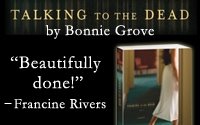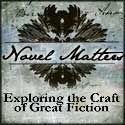Kelly McCrady is back today with part II her article on being a writer AND an editor. Last time she spoke to us wearing her writer's hat. Today, take cover, because she's an editor - and she and her furious red pen have plenty to say!
Part II: “Dishing it out”
We turn now to the dark side, the Cave of the Editor.
The inbox dings. Message incoming from Senior Editor. “We have a query that looks fairly decent. You want to take this one?” Attached synopsis and query letter read okay, though the author is most likely unaware of how her lack of polish in the spelling, grammar and syntax makes her appear. No matter. The story seems to fit my line and the basic premise of a romance book, so I contact the author. I ask for the partial manuscript.
The partial arrives, and I schedule a time to do the read-through. Contact author, let her know the file arrived and when to expect an answer.
Edit books 1,2, and 3 currently on my desk. A gap will happen after book 3 is sent to galley-land, so at that time (no more than 60 days from receipt of initial query) I open the partial manuscript from Hopeful Author and read.
What you need to know as an author is that a book is judged as good or bad within the first six pages.
Six pages.
This does not mean the content cannot make or break the story’s potential after that, merely that my impulse to continue reading is generally triggered either direction by page six. If the prose isn’t up to publishable standard, as set down by my superiors at the publisher, I begin to compose the rejection letter. I look specifically for craft areas the author can improve on. That’s what we do at The Wild Rose Press—no form letters allowed.
If the first six pages have grabbed me so well that I’ve read to page fifteen without noticing, that is a good thing. I usually stop there and email the author to send me the full manuscript.
When that full arrives (you’d be amazed at the speed of email when it’s a positive experience for both parties), I open the file to be sure it is in one piece, alert the author that it did arrive, and again schedule a time to do the read-through.
The most difficult part of reading full manuscripts for consideration is NOT EDITING THEM. Forcing myself to read, and read only for content, plot, character, structure, voice…any one of those can go sadly awry beyond what I expected from reading the polished partial.
If I reach the end of the book and don’t have that “Yay! Good book!” feeling (and yes, books with problems such as head hopping, too many adverbs, unclear transitions, echo words, “junk” words, poor use of commas, etc. CAN give me that feeling, if everything else is right about the plot and structure and characters) then I have to compose a rejection. So hard to do that, when a book is almost there but not quite yet.
A fair percentage of the books I have rejected were excellent, well-written, stirring prose…but were not romances. Authors, make certain you follow the publisher’s submission guidelines. Look through their catalogue to see what else they publish, read blurbs, excerpts, look at cover art. For example, a good adventure with a love story entwined in the plot cannot be categorized as a romance if the hero and heroine marry on page 60 of a 380 page book and continue to work together to bring down their foe.
When a manuscript is accepted for publication, that manuscript will undergo at least one round of copyedits. Some writers are so clean that the only marks the editor makes regard pulling the punctuation in line with house style (for example, the serial comma in a list with a conjunction—leave it in? Take it out?). More often, though, the editor will have questions about content that is inconsistent within the manuscript, and guide the author into smoothing these bits so the reader will not hit “speedbumps.”
My favorite trick for tracking consistency within a manuscript is to set up a chart, a style sheet, broken down into pairs of letters, A-Z, and a column for miscellaneous facts. While reading for the first edit, I write down the name of every character as I run across them, every fact (Brandy lost her locket on Tuesday), and when I get tidbits of character description, I add that after the character’s name, to keep a running list of how this person is described.
This style sheet helps in two ways—easy to see if facts such as a character’s hair or eye color suddenly changes, and also to find repeat descriptions. One of my authors caught that she referred to the hero’s hair as “shaggy” way too often, and that she alternated between the words “couch” and “sofa,” ultimately choosing only one.
The editor’s job is to make the author look good. I polish my “babies” and declare when they are ready to go out into the world, the proud auntie of all the books I’ve worked on. In the end, few acknowledge the editor’s hand in making the story richer, better, deeper. The publisher’s name is on the book, and the author’s name. Once in a while, you’ll see a thank you to an editor in the dedication.
Remember, your editor is invested in your story too. She loved it when she read it the first time. And she contracted it knowing she’d have to read it over and over and over…
Be professional in your communications with your editor. As gabby as authors are, editors are just as talkative. If you have not received an answer, feel free to ask your questions again—emails can and do disappear. But be polite on the second ask as though the first was not heard. Allow your editor time to find your answer and reply. Sometimes she or he is waiting on someone else in the company in order to give you the best information.
I enjoy editing. I enjoy interacting with authors. I enjoy being an author. I do not enjoy interacting with editors as an author LOL. So I hear you. I’m still going to change the wording in that sentence, because it does not mean what you wanted it to say.
Kelly McCrady’s newest short story “Martial Hearts” is available October 15 from The Wild Rose Press http://www.thewildrosepress.com/ . Author website is http://www.kellymccrady.com/
*****
This is worth a second, maybe even third read. It's chock-a-block with little tidbits, great advice, and "soft knowledge" every writer needs to know. I know we all want to be the writer who produces that "Yay! Good book!" feeling in an editor. Let's keep at it!
I bid you good writing.
Subscribe to:
Post Comments (Atom)









4 comments:
Great post, Bonnie. Very helpful. Fun to see inside the process a little bit!
Extremely insightful and encouraging. So my ms needs to be my best work but it doesn't have to solve the mystery of Camelot too in order to get a full request. :)
Thanks Bonnie and Kelly for sharing.
Good stuff. Thanks.
Nice to see the process, the behind-the-scenes type things that we don't think of (like how many projects the editor is in the middle of). And to get an idea of what little things an editor can help us improve--because its often the little things that get overlooked when we're writing. :)
Post a Comment